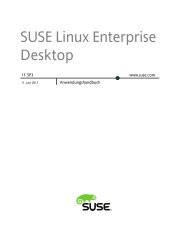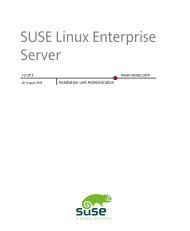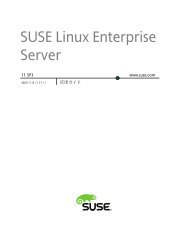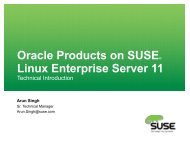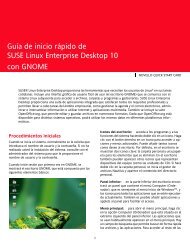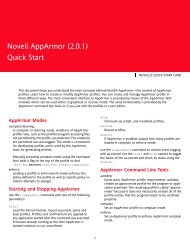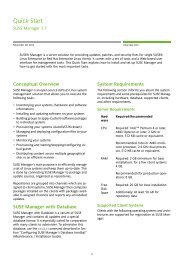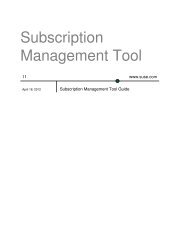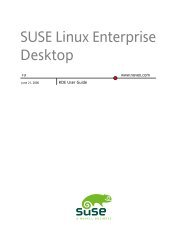SUSE Linux Enterprise Server Starter System for System z ...
SUSE Linux Enterprise Server Starter System for System z ...
SUSE Linux Enterprise Server Starter System for System z ...
Create successful ePaper yourself
Turn your PDF publications into a flip-book with our unique Google optimized e-Paper software.
Installing the <strong>SUSE</strong> <strong>Linux</strong> <strong>Enterprise</strong> <strong>Server</strong> <strong>Starter</strong><br />
<strong>System</strong> <strong>for</strong> <strong>System</strong> z<br />
This section describes a step by step installation of the <strong>SUSE</strong> <strong>Linux</strong> <strong>Enterprise</strong> <strong>Server</strong><br />
<strong>Starter</strong> <strong>System</strong> <strong>for</strong> <strong>System</strong> z.<br />
Be Sure to Read the Procedure Completely Be<strong>for</strong>e Beginning<br />
To make sure you understand the process and steps, read the entire procedure through<br />
at least one time from start to finish and ensure that you have completed the planning<br />
worksheets and have all the materials ready be<strong>for</strong>e beginning to install the starter<br />
system.<br />
For illustration purposes, the installation procedure assumes you will use VM userid<br />
NOVSTART <strong>for</strong> the starter system as shown in the sample CP directory entry file. Any<br />
userid may be used, however you will need to modify this procedure according to your<br />
local conventions.<br />
Preparing the Virtual Machine<br />
1. Create the virtual machine NOVSTART using your local CP directory maintenance<br />
procedures. Note that the MDISK entries in the sample directory entry are commented<br />
out, and should be used <strong>for</strong> guidance and disk sizing. The real entries will be<br />
added in a later step.<br />
Elevated CP Privileges Are Not Required<br />
The starter system virtual machine does not require any privileges beyond the<br />
normal class G privileges available to an ordinary z/VM user. You should not<br />
grant the starter system virtual machine any additional privileges unless you fully<br />
understand the results and risks associated.<br />
2. Add the minidisks specified in the worksheet using your local directory management<br />
procedures. You can use the comments in the sample directory entry or the planning<br />
worksheet values to estimate the amount of space needed.<br />
If using 3390 model 3 volumes, approximately two full volumes will be required. If<br />
using 3390 model 9 or 27 volumes, only a fraction of one volume will be required,<br />
however there will be a per<strong>for</strong>mance impact if all the minidisks are located on the<br />
same volume.<br />
If you are not using an external security manager such as RACF on your z/VM<br />
system, ensure that you add minidisk passwords to the minidisks. The 19F minidisk<br />
will need public access, and should be assigned a read password of ALL. Example<br />
MDISK entries might appear similar to these:<br />
10 Installing the <strong>SUSE</strong> <strong>Linux</strong> <strong>Enterprise</strong> <strong>Server</strong> <strong>Starter</strong> <strong>System</strong> <strong>for</strong> <strong>System</strong> z



